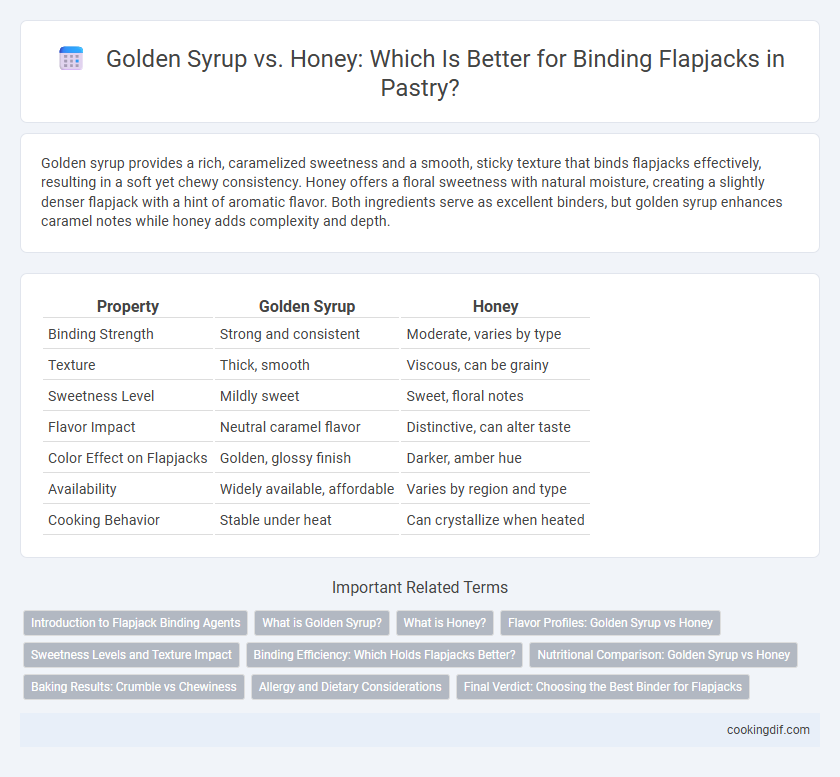Golden syrup provides a rich, caramelized sweetness and a smooth, sticky texture that binds flapjacks effectively, resulting in a soft yet chewy consistency. Honey offers a floral sweetness with natural moisture, creating a slightly denser flapjack with a hint of aromatic flavor. Both ingredients serve as excellent binders, but golden syrup enhances caramel notes while honey adds complexity and depth.
Table of Comparison
| Property | Golden Syrup | Honey |
|---|---|---|
| Binding Strength | Strong and consistent | Moderate, varies by type |
| Texture | Thick, smooth | Viscous, can be grainy |
| Sweetness Level | Mildly sweet | Sweet, floral notes |
| Flavor Impact | Neutral caramel flavor | Distinctive, can alter taste |
| Color Effect on Flapjacks | Golden, glossy finish | Darker, amber hue |
| Availability | Widely available, affordable | Varies by region and type |
| Cooking Behavior | Stable under heat | Can crystallize when heated |
Introduction to Flapjack Binding Agents
Golden syrup and honey serve as popular binding agents in flapjack recipes due to their viscosity and sweetness. Golden syrup, a byproduct of sugar refining, offers a buttery caramel flavor and smooth texture that enhances the chewiness of flapjacks. Honey, derived from nectar and possessing antimicrobial properties, provides a floral sweetness and sticky consistency that helps hold the oats and other ingredients together effectively.
What is Golden Syrup?
Golden syrup is a thick, amber-colored invert syrup made from refined sugar cane or sugar beet juice, commonly used in baking for its rich, caramelized flavor and sticky texture. It acts as an effective binder in flapjacks by creating a chewy consistency while adding moisture and sweetness. Unlike honey, golden syrup has a more neutral sweetness and caramel notes, making it ideal for balancing flavors in sweet pastries.
What is Honey?
Honey is a natural sweetener produced by bees from flower nectar, containing fructose, glucose, enzymes, and trace minerals that contribute to its rich flavor and sticky texture. Its natural antibacterial properties and moisture-retaining qualities make it an effective binding agent in flapjacks, enhancing both taste and shelf life. Unlike golden syrup, honey offers a more complex flavor profile with floral notes and varied sweetness levels depending on the nectar source.
Flavor Profiles: Golden Syrup vs Honey
Golden syrup imparts a rich, caramel-like sweetness with buttery undertones that intensify the flapjacks' flavor, while honey offers a floral, fruity note that can vary depending on its botanical source. The smooth, syrupy texture of golden syrup provides consistent moisture and binding, creating a chewy flapjack, whereas honey's natural viscosity can introduce subtle tanginess and complexity. Choosing between golden syrup and honey significantly influences the overall taste and mouthfeel of flapjacks, catering to different flavor preferences and regional variations in pastry recipes.
Sweetness Levels and Texture Impact
Golden syrup provides a smooth, thick consistency that binds flapjacks firmly while imparting a rich caramel sweetness, enhancing chewiness and moisture retention. Honey contributes a floral sweetness with varying intensity depending on variety, adding a stickier texture and subtle complexity to the flapjack's crumb. The choice between golden syrup and honey affects both sweetness levels and texture, influencing the final balance of flavor and structural integrity in baked flapjacks.
Binding Efficiency: Which Holds Flapjacks Better?
Golden syrup offers superior binding efficiency for flapjacks due to its thicker, more viscous texture that helps ingredients adhere firmly during baking. Honey's natural stickiness provides some hold but its thinner consistency can result in flimsier flapjacks that may crumble more easily. The dense, caramelized properties of golden syrup create a robust structure, ensuring flapjacks maintain their shape better under heat and handling.
Nutritional Comparison: Golden Syrup vs Honey
Golden syrup contains approximately 60 calories and 15 grams of sugar per tablespoon, offering a high glycemic index that can cause rapid blood sugar spikes. Honey provides around 64 calories and 17 grams of natural sugars per tablespoon but includes trace amounts of vitamins, antioxidants, and antimicrobial properties. For binding flapjacks, honey delivers slightly more nutrients and a lower glycemic impact compared to the refined sugars in golden syrup, making it a potentially healthier choice.
Baking Results: Crumble vs Chewiness
Golden syrup creates flapjacks with a tender crumb and slightly chewy texture due to its thick, viscous consistency and caramelized sugars that help bind ingredients without excess moisture. Honey, with its higher moisture content and natural acidity, tends to produce flapjacks that are stickier and more chewy, sometimes sacrificing a light crumble in favor of a denser bite. Choosing golden syrup for binding enhances a balanced texture that crisps at the edges while maintaining softness inside, whereas honey results in a more cohesive, sticky chewiness.
Allergy and Dietary Considerations
Golden syrup, a vegan-friendly sweetener derived from sugar cane or sugar beet, is free from common allergens like nuts and gluten, making it suitable for people with specific dietary restrictions. Honey, although natural and rich in antioxidants, is not vegan and may cause allergic reactions in individuals sensitive to bee products or pollen. Choosing between golden syrup and honey for binding flapjacks depends on dietary preferences, potential allergies, and ethical considerations.
Final Verdict: Choosing the Best Binder for Flapjacks
Golden syrup provides a rich, caramelized flavor and a smooth, sticky texture that enhances flapjack binding and moisture. Honey offers natural sweetness and a slightly floral taste but tends to be less viscous, potentially impacting the flapjack's hold and chewiness. For the best binder in flapjacks, golden syrup is often preferred due to its superior binding strength and consistent texture.
Golden Syrup vs Honey for binding flapjacks Infographic

 cookingdif.com
cookingdif.com